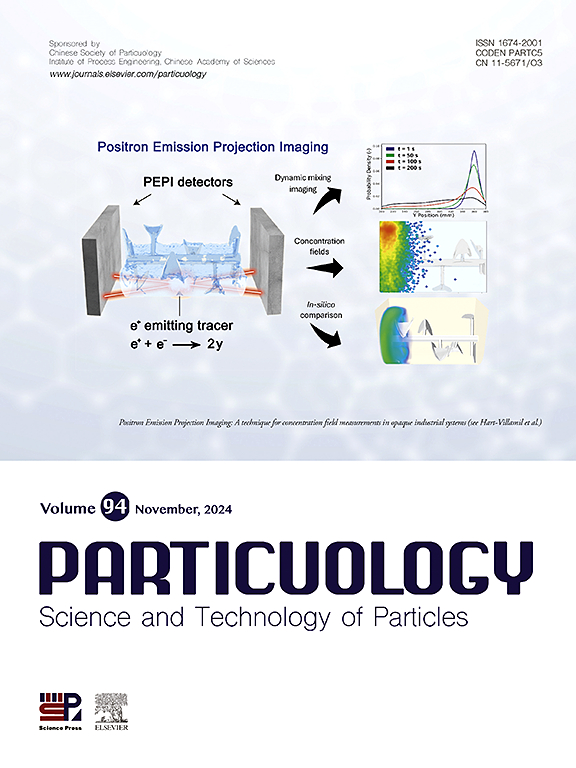用Mg2+浓海水盐水可控合成均匀小粒径MgCO3,制备环氧树脂复合材料和高纯MgO
IF 4.1
2区 材料科学
Q2 ENGINEERING, CHEMICAL
引用次数: 0
摘要
无水碳酸镁(MgCO3)晶粒尺寸大且不均匀严重限制了其应用范围和性能。在本研究中,我们提出了一种在没有晶体改性剂的情况下,从Mg2+浓海水盐水中合成均匀小粒径MgCO3的可控且经济的策略。该工艺将固体NaOH直接加入到Mg2+浓盐水中,使Mg2+完全快速转化为氢氧化镁(Mg(OH)2)纳米颗粒。这些纳米颗粒再分散在水中形成胶体体系,其中Mg(OH)2纳米颗粒与尿素水热反应得到均匀的小尺寸MgCO3颗粒。系统地考察了反应温度、反应时间和镁离子与尿素的摩尔比对MgCO3合成的影响。在高度分散和稳定的胶体体系中,Mg(OH)2纳米颗粒通过吸附游离水对尿素的水解速率起到有效和持续的延缓作用,使NH4+、CO32−和Mg2+的释放可控。本研究为实现均匀小粒径MgCO3颗粒的可控合成提供了一条简单的途径,并证明了MgCO3作为提高聚合物性能的理想填料和生产高纯度MgO的理想前驱体的可行性。本文章由计算机程序翻译,如有差异,请以英文原文为准。

Controllable synthesis of uniform small-sized MgCO3 from Mg2+ concentrated seawater brine for the preparation of epoxy resin composite and high purity MgO
The large and uneven grain size of anhydrous magnesium carbonate (MgCO3) seriously restricts its application ranges and performances. In this study, we proposed a controllable and cost-effective strategy to synthesize uniform small-sized MgCO3 from Mg2+ concentrated seawater brine in the absence of crystal modifiers. In this process, solid NaOH was directly added to Mg2+ concentrated seawater brine to completely and rapidly convert Mg2+ to magnesium hydroxide (Mg(OH)2) nanoparticles. These nanoparticles are redispersed in water to form the colloidal system, where Mg(OH)2 nanoparticles hydrothermally reacts with urea to obtain uniform small-sized MgCO3 particles. The influence of reaction temperature, reaction time, and the molar ratio of magnesium ions to urea on the synthesis of MgCO3 is systematically investigated. In the highly-dispersed and stable colloidal system, Mg(OH)2 nanoparticles could exert an effective and sustained retarding effect on the hydrolysis rate of urea by attracting free water, resulting in the controllable release of NH4+, CO32−, and Mg2+. This study presents a simple route to realize the controllable synthesis of uniform small-sized MgCO3 particles, and demonstrates the feasibility of using MgCO3 as an ideal filler for enhancing the performance of polymers as well as an ideal precursor for high-purity MgO production.
求助全文
通过发布文献求助,成功后即可免费获取论文全文。
去求助
来源期刊

Particuology
工程技术-材料科学:综合
CiteScore
6.70
自引率
2.90%
发文量
1730
审稿时长
32 days
期刊介绍:
The word ‘particuology’ was coined to parallel the discipline for the science and technology of particles.
Particuology is an interdisciplinary journal that publishes frontier research articles and critical reviews on the discovery, formulation and engineering of particulate materials, processes and systems. It especially welcomes contributions utilising advanced theoretical, modelling and measurement methods to enable the discovery and creation of new particulate materials, and the manufacturing of functional particulate-based products, such as sensors.
Papers are handled by Thematic Editors who oversee contributions from specific subject fields. These fields are classified into: Particle Synthesis and Modification; Particle Characterization and Measurement; Granular Systems and Bulk Solids Technology; Fluidization and Particle-Fluid Systems; Aerosols; and Applications of Particle Technology.
Key topics concerning the creation and processing of particulates include:
-Modelling and simulation of particle formation, collective behaviour of particles and systems for particle production over a broad spectrum of length scales
-Mining of experimental data for particle synthesis and surface properties to facilitate the creation of new materials and processes
-Particle design and preparation including controlled response and sensing functionalities in formation, delivery systems and biological systems, etc.
-Experimental and computational methods for visualization and analysis of particulate system.
These topics are broadly relevant to the production of materials, pharmaceuticals and food, and to the conversion of energy resources to fuels and protection of the environment.
 求助内容:
求助内容: 应助结果提醒方式:
应助结果提醒方式:


